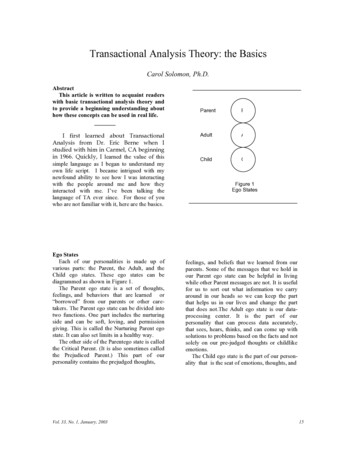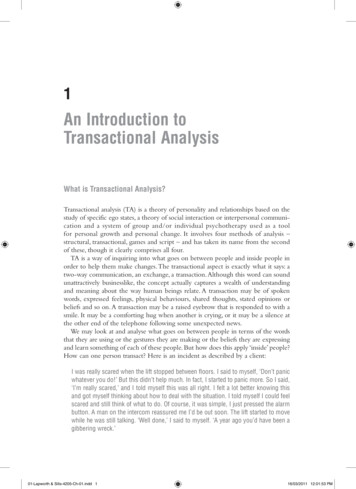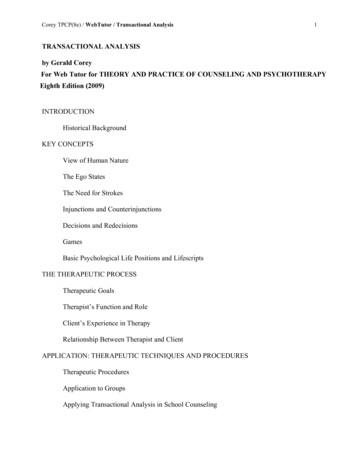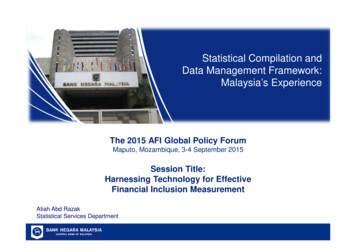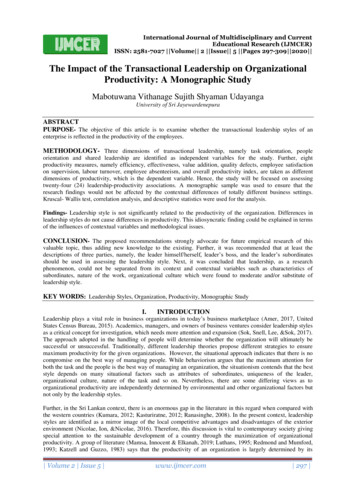
Transcription
International Journal of Multidisciplinary and CurrentEducational Research (IJMCER)ISSN: 2581-7027 Volume 2 Issue 5 Pages 297-309 2020 The Impact of the Transactional Leadership on OrganizationalProductivity: A Monographic StudyMabotuwana Vithanage Sujith Shyaman UdayangaUniversity of Sri JayewardenepuraABSTRACTPURPOSE- The objective of this article is to examine whether the transactional leadership styles of anenterprise is reflected in the productivity of the employees.METHODOLOGY- Three dimensions of transactional leadership, namely task orientation, peopleorientation and shared leadership are identified as independent variables for the study. Further, eightproductivity measures, namely efficiency, effectiveness, value addition, quality defects, employee satisfactionon supervision, labour turnover, employee absenteeism, and overall productivity index, are taken as differentdimensions of productivity, which is the dependent variable. Hence, the study will be focused on assessingtwenty-four (24) leadership-productivity associations. A monographic sample was used to ensure that theresearch findings would not be affected by the contextual differences of totally different business settings.Kruscal- Wallis test, correlation analysis, and descriptive statistics were used for the analysis.Findings- Leadership style is not significantly related to the productivity of the organization. Differences inleadership styles do not cause differences in productivity. This idiosyncratic finding could be explained in termsof the influences of contextual variables and methodological issues.CONCLUSION- The proposed recommendations strongly advocate for future empirical research of thisvaluable topic, thus adding new knowledge to the existing. Further, it was recommended that at least thedescriptions of three parties, namely, the leader himself/herself, leader‟s boss, and the leader‟s subordinatesshould be used in assessing the leadership style. Next, it was concluded that leadership, as a researchphenomenon, could not be separated from its context and contextual variables such as characteristics ofsubordinates, nature of the work, organizational culture which were found to moderate and/or substitute ofleadership style.KEY WORDS: Leadership Styles, Organization, Productivity, Monographic StudyI.INTRODUCTIONLeadership plays a vital role in business organizations in today‟s business marketplace (Amer, 2017, UnitedStates Census Bureau, 2015). Academics, managers, and owners of business ventures consider leadership stylesas a critical concept for investigation, which needs more attention and expansion (Sok, Snell, Lee, &Sok, 2017).The approach adopted in the handling of people will determine whether the organization will ultimately besuccessful or unsuccessful. Traditionally, different leadership theories propose different strategies to ensuremaximum productivity for the given organizations. However, the situational approach indicates that there is nocompromise on the best way of managing people. While behaviorism argues that the maximum attention forboth the task and the people is the best way of managing an organization, the situationism contends that the beststyle depends on many situational factors such as attributes of subordinates, uniqueness of the leader,organizational culture, nature of the task and so on. Nevertheless, there are some differing views as toorganizational productivity are independently determined by environmental and other organizational factors butnot only by the leadership styles.Further, in the Sri Lankan context, there is an enormous gap in the literature in this regard when compared withthe western countries (Kumara, 2012; Kasturiratne, 2012; Ranasinghe, 2008). In the present context, leadershipstyles are identified as a mirror image of the local competitive advantages and disadvantages of the exteriorenvironment (Nicolae, Ion, &Nicolae, 2016). Therefore, this discussion is vital to contemporary society givingspecial attention to the sustainable development of a country through the maximization of organizationalproductivity. A group of literature (Mamsa, Innocent & Elkanah, 2019; Luthans, 1995; Redmond and Mumford,1993; Katzell and Guzzo, 1983) says that the productivity of an organization is largely determined by its Volume 2 Issue 5 www.ijmcer.com 297
The Impact of the Transactional Leadership leadership. More specifically, it is the leadership styles, i.e., task orientation and people orientation that decidethe level of productivity. However, another group of literature (Brown, 1982; Meindle, 1985: Pfeiffer, 1977:Miner, 1982) challenges this proposition, saying that leadership has only a minimal relationship withproductivity, as organizational outcomes are determined primarily by environmental factors. Therefore, thiscontradiction on leadership styles and its impact on productivity lead to the identification of a research problemthat is worth studying. Hence, the research problem addressed in this paper is, “Do the leadership stylesinfluence and explain the variations in the productivity”. Therefore, this article aims at (1) examining therelationship between leadership styles and productivity, (2) identifying whether the differences in the leadershipstyles cause differences in the productivity, and (3) to have an insight into the impact of situational factors onthe leadership style and productivity.In order to fulfill this requirement, at the outset, theoretical concepts of leadership styles and the productivity ofthe organization were studied to identify the different types of dimensions based on the suitable theories,approaches, and models. It is indicated to develop a conceptual framework depicting the impact of leadershipstyles have, with the dimensions exclusively selected for this article, in relation to the exhaustive literaturereview on the subject of organization productivity. Therefore, the ultimate intention of this article is to examinethe dimensions in relation to the variables and the proposed conceptual framework, consisting of dimensions inrelation to different disciplines that would be explored in future studies especially focusing on the apparelindustry around the world. Furthermore, researchers are allowed to discover the associations among variousacademic approaches, learning outcomes, and subsequent business performance by exploring leadership styleswhich is an area that needs continuing research (Buckley, 2014; Fani, 2015). It is also worthwhile to note thatleadership could be validated and tested through the manufacturing sector in different industries and countries(Dermol, 2010), including Sri Lanka. In order to establish a strong basis on the vitality of these mainconstructions, a sound theoretical review of the literature is essential.II.LITERATURE REVIEWTheoretical Development: Theories need not be regarded to be only academic since these assist to comprehendbasic concepts that are necessary to take decisions and actions with a clear mind in an enhanced manner ratherthan without any explanation or theory. At all potential levels, theories can basically have an impact oninfluencing conclusion and action. The disputes that arise inconsequent to disparities in descriptions could bedue to the theories that require testing. This section provides a brief explanation for the literature related to thetopic of the study.The study mainly focuses on the examination of the impact of leadership styles on the productivity of a selectedgarment – manufacturing organization in Sri Lanka. The study adopts the two-dimensional view of leadership:task-orientation and people orientation. Further, the literature reveals that task-orientation and people-orientationare not incompatible, and skillful leaders can combine these orientations in their overall style to producefavorable results. Accordingly, the study identifies this dimension of leadership as “Shared Leadership.” Theproductivity is assessed in relation to the measures of efficiency, value addition, effectiveness, quality defects,and labour turnover, employee absenteeism, and employee satisfaction on supervision. Being understood,through in-depth literature reviews, that leadership is a more abstract and theoretical concept, the presentresearch selected to provide an empirical light in explaining such leadership models in an empirically groundedmanner.Productivity : Productivity isn't everything, but in the long run, it is almost everything. A country's ability toimprove its standard of living over time depends almost entirely on its ability to raise its output per worker(Thoradeniya, 1998). Productivity is the belief in human progress. It is a state of mind which aims at perpetualimprovement. It is a ceaseless effort to apply new technology and new methods for the welfare and happiness ofhumankind. It is the training of the minds and the development of attitudes of the people as a whole, whichdetermines whether the nation will realize high productivity and an affluent life or low productivity andpoverty"(Asian Productivity Organisation, 2012). Volume 2 Issue 5 www.ijmcer.com 298
The Impact of the Transactional Leadership Productivity of Organizations : Efficiency, effectiveness and quality are the few dimensions of theproductivity of organizations. There are few needful to do if productivity in the organization to be maximized.Those are namely set mutual expectations with the team; agree that leaders are fair and reasonable; measurecurrent productivity; set targets; provide visible feedback; discuss progress on a regular basis; and celebratemilestones and achievements (Mitchell, 2016).Various tools and methods to improve productivity in the organization presented in figure 2.EfficiencyEffectivenessQualityDoing Things RightDoing the Right ThingEligibility for PurposeProductivityFigure 2: Various Dimensions of the productivityThe focus is given in this section to identify some of the concepts which can be ideally used in conceptual andtheoretical backgrounds. Due to the sheer ability of the infrastructure geared towards productivity, many of theconcepts given below are well-practiced in Japan. Nevertheless, due to the infrastructural and attitudinal factorsin countries like Sri Lanka, it is a challenge to implement and practice the concepts which help improveproductivity.Transactional Leadership : Transactional leadership involves an exchange relationship between leaders andfollowers in the direction of established goals by clarifying role and task requirement. Transactional leaders‟focus is to maintain the status quo and they are oriented to enhance the present way of doing things.Transactional leadership involves two major dimensions namelytask orientation and people orientation.Nevertheless, it is very difficult to find fully task oriented or people oriented leaders. Instead we find leaderswith a combination of both characteristics. In this research, such leaders are labeled as Shared Leadership.Task-orientation is the degree to which the leader organizes and defines relationships in the group by activitiessuch as assigning specific tasks;specifying procedures to be followed; scheduling work, and clarifyingexpectations; encourage people to work harder; emphasize t deadlines; see to it that people in the work groupare working up to capacity; closely supervise employees; and getting the job done is more important to themthan employees‟ growth or personal satisfaction.People orientation is the degree to which the leader creates anenvironment of emotional support, warmth, friendliness, and trust. Employee oriented leaders arefriendly;trustful; earn respect; have a warm relationship with team members; do personal favours for people inthe work group; treat all people in the work group as his/her equal; be willing to make changes; back up whatpeople; and have a participative decision making.While advancing Burns (1978) model, Bass (2004) proposed a new theory of transformational leadership andoutlined its components. To understand transformational leadership, we must differentiate it from transactionalleadership. Transactional leadership is based on the exchange process, where the leader administers rewards andsanctions. The leader and follower agree, explicitly or implicitly, that desired follower behaviors will berewarded, while undesirable behaviors will draw out punishment. Potential rewards include an increase insalary, promotions, and more benefits. Conversely,penalties may include pay cuts, demotions, and terminations.Based on this, one could argue that transactional leadership behaviors do not even qualify for a “true” leadershiplabel (Brown and Thoranton, 2013). Since it is based on exchange, transactional leadership does not seek tomotivate followers beyond the level that is required to avoid punishment or gain extrinsic rewards. Accordingly,total reliance on this leadership style may cause performance and satisfaction to suffer (Bass, 1985; Burns;1978). Transformational leadership, however, engages followers by appealing to their upper-level needs andideals that yield higher levels of follower satisfaction and performance (Bass, 1985). Volume 2 Issue 5 www.ijmcer.com 299
The Impact of the Transactional Leadership Transformational leadership: Transformational leadership is based more on leaders‟ shifting the values,beliefs and needs of their followers. Further, these leaders provide individualized consideration, and intellectualstimulation and possess charisma.Unlike Burns (1978), Bass (1985) insists that, to be effective, leaders need to demonstrate features of bothtransactional and transformational leadership. Empirical evidence tends to support the view that leaders willmaximize their effectiveness when they exhibit both transformational and transactional behaviors (Bass, &Yammarino, 1989).Romance of Leadership : Romance of leadership as a construct refers to the generalized beliefs thatindividuals have regarding the significance of leadership to organizations, which may influence how they seetheir leaders (Meindl, Ehrlich, and Dukerich; 1985). These beliefs enhance followers‟ perceptions ofcharismatic/transformational qualities. Meindl and Ehrlich (1988) have developed the Romance of LeadershipScale (RLS). However, up to this point, only inconclusive empirical evidence is available regarding this concept(Meindl; 1988).Methodological Issues in Selecting the Sample: One of the significant issues in the discussion of leadership,concerns the limited attention given to the effects of the organizational environment (Hunt and Osborn, 1982).Most leadership research has either isolated the leader‟s behavior from its effects or isolated the effects from theleader‟s behavior (Campbel et al., 1970). According to Campbel et al.this occurs due to the bias towardsinstrument-centered research, in which aspects of the environment, cognition, behavior, and organizationaloutcomes are studied separately rather than together. This has happened because in this traditional, nomotheticresearch constructs, researchers have attempted to discover generalizable laws or propositions of behavior byaveraging responses for each separate variable while using group-comparisons designs (Davis and Luthans,1984). It is a general trend in these nomothetic research constructs that very few variables are tested, taking alarge sample. This has resulted in reductionist tendencies in leadership research in which categories that aregeneral in nature are singled out because they appear to explain a great deal (Campbel et al, 1970). Thisapproach to leadership has failed, mainly because researchers have not been able to link together the results ofthese numerous separate studies to produce an improved overall understanding of leadership (David andLuthans, 1984). Therefore it is evident that one of the main instrumental biases on which those nomotheticresearch constructs are built is the sample size that permits generalizable laws but ignores the contextualdifferences. Having understood this truth, this research is limited to a monographic site, as it would ensure thatthe research findings would not be affected by contextual differences of totally different business settings.Further, this permits the researchers to get a clear insight into the impact of situational factors on the leadershipand productivity.Having understood this reality of difficulty of separating the leadership from its context the research was limitedto a monographic site, as it would ensure that the research findings would not be affected by contextualdifferences of totally different business settings.Sample Profile : The organization selected for this purpose is a large-scale garment factory, located in theCentral Province, about 90-km away from Colombo. The total workforce of this organization consists of 1300employees, belong to eight different hierarchical strata from which five are identified as staff levels.The staffmembers amount to 173. There are 11 sewing lines with 500 machines. The plant consists of a floor area of55000 sq. feet and most of the members of the lower level management and almostall of the labour gradeemployees are from the vicinities of the factory. Most of them do not possess a good educational background; tobe specific hardly anyone who sat for the General Certificate in Education Advances Level (GCE,A/L)examination can be found among them. Majority of the lower level managers, especially in the productiondepartment, are the people who were promoted to those positions from the lower grades, after being identifiedby the authority as the people with higher level of potential necessary to perform supervisory jobs. At theinterviews that the researcher had with those lower level managers and operational level workers, theypretended to be so loyal and committed to the organization; however, in contrast to this, labour turnover ratewas around 5% during the past few years, which was far higher than the industry average of 2.5%. Furtheremployee absenteeism was found to be a major barrier in meeting the daily targets. Almost all of the top leveland middle level managers possess sound educational background plus professional qualifications. The presentChief Executive Officer (CEO) of the factory has started his career at this organization as the Factory Manager(FM) and was promoted first to the post of General Manager (GM) and then to the post of Director. It can beseen that this person is a sort of leader who gives more attention to details with little delegation. Volume 2 Issue 5 www.ijmcer.com 300
The Impact of the Transactional Leadership Most of the workers and managers were found to be dissatisfied with the present work environment. Littleconcern had been paid to employees‟ health &safety and, machine operators and helpers with dusty hair is acommon sight in the factory. However, welfare facilities such as provisions of distress loans, housing loans, freelunch, and annual picnic are available for both staff grade and labour grade employees. The organization haspaid much attention to the management development and, managers from the supervisory level to the top levelhave been provided with chances to improve their supervisory and managerial knowledge, skills and attitudesthrough workshops and seminars conducted by the professional bodies in the field.The production department ofthe factory is under the direct supervision of the FM and, it has been subdivided into two areas that come underthe control of two “Area Managers” (AM). While area – I consists of 05 sewing lines namely A,B,C,D and H,area – II consists of 06 sewing lines namely E, F, G, I, J and K. However it should be noted that the lines J andK were not included in the sample of the nine sewing lines selected for the study. These have been dividedamong three Assistant Production Managers (APM) who directly handle the activities of 09 ProductionSupervisors (PS). These production executives together with PS closely oversee the work of 432 MachineOperators (MO) and 78 Helpers (HLP). There is at least one Production Executive (PE) and one PS for each lineand a sewing line consists of approximately 48 MO. Even though organizational positions are hierarchicallyarranged according to the position‟s power, the principle of unity of command is not preserved in the productiondepartment. Instead, a multiple command situation can be seen throughout the organization chart. This situationis depicted in Figure 01.III.METHODOLOGYBoth primary and secondary sources of data were used. Personally administered Likert Scale questionnaireswere used in collecting data on leadership style and employees‟ satisfaction. Further, structured andunstructured interviews were conducted with managers and non-managerial employees. Besides these primarysources of collecting data, different documents periodically prepared by the organization, such as annualbusiness plans, monthly progress reports, etc. were used in collecting productivity-related data. Bothquantitative and qualitative analyses were used together with descriptive statistics where appropriative.Table 1: Generally Hypothesized Relationships between Leadership Styles and ProductivityLeadership StyleProductivity MeasurePeople OrientationTask OrientationShared edRelationshipPositivePositivePositivePeople OrientationTask OrientationShared ositivePositivePositivePeople OrientationTask OrientationShared LeadershipValue AdditionValue AdditionValue AdditionPositivePositivePositivePeople OrientationTask OrientationShared LeadershipLabour TurnoverLabour TurnoverLabour TurnoverNegativePositiveNegativePeople OrientationTask OrientationShared LeadershipEmployee AbsenteeismEmployee AbsenteeismEmployee AbsenteeismNegativePositiveNegativePeople OrientationTask OrientationShared LeadershipQuality DefectsQuality DefectsQuality DefectsNegativeNegativeNegativePeople OrientationTask OrientationShared LeadershipSatisfaction on SupervisionSatisfaction on SupervisionSatisfaction on SupervisionPositiveNegativePositive Volume 2 Issue 5 www.ijmcer.com 301
The Impact of the Transactional Leadership People OrientationTask OrientationShared LeadershipSource : Literature ReviewOPIOPIOPIPositivePositivePositiveThe following statistical techniques are used for the analysis: Kruskal – Wallis Test, Correlation Analysis andDescriptive Statistics. With the help of the literature, a set of behavioural characteristics of leaders that can beused to distinguish between their task orientation and people orientation could be identified as type ofsupervision; mutual trust; emotional and Psychological Support; concern for the employee wellbeing anddevelopment; compliance to rules and regulations; meeting deadline and concern for task; type ofcommunication; and mutual relationship and friendship. The questionnaire for assessing leadership style,consisted of 30 questions and above characteristics. The questionnaire was structured into two parts, namely partI and II. Part I covered the conative aspects of the leadership behavior whereas; part II covered the cognitiveaspects of the leadership behavior. Further, Likert Scale questionnaire with seven questions was developed tomeasure the employees‟ satisfaction on supervision. Both of these questionnaires were personally administeredby the researcher to all the respondents with the purpose of guaranteeing the accuracy of the responses to a greatextent.According to the available literature generally hypothesized relationships between leadership styles andorganizational productivity measures are given in Table 1.Table 2: Weightings of the managerial positionsManagerial PositionsFactory ManagerArea ManagerAsst. Production managerProduction ExecutiveProduction SupervisorTotalWeight1134110After a discussion with top level managers of the factory a conclusion was arrived at as to the weight themanagerial levels according to the impact that each of these managerial levels have, on the operational levelworkers. This weighting system is given in Table 2 for the purpose of testing the association between leadershipstyle values and productivity scores, 54 leadership situations are created by applying the weighted averageleadership values of each production line to the monthly productivity values of respective lines.Analysis: Weighted average leadership style values for each production line in relation to the task orientation,people orientation and shared leadership were calculated using the responses given to the questionnaires.Tofacilitate the comparison of leadership style values with productivity values, weighted average leadership valuesof production lines were classified in to five leadership levels, from 1 to 5. Monthly values of each productivitymeasure for the period of six months, in relation to each production line were identified for the purpose ofanalysis. Bringing the data given in Table 4 and monthly productivity data together created the leadership –productivity data matrix. This matrix describes the leadership style values and productivity values in relation tothe 54 leadership situations identified. This was the base for the analysis. As explained earlier the KruskalWallis test of ANOVA and correlation analysis were employed for the purpose of data analysis. Firstly, theKrruskal-Wallis test is used to determine whether there are significant differences among levels of leadership,the median values of productivity measures (as used by Kruskal-Wallis test) are plotted against the levels ofleadership to visualize the relationship,if any, between the two sets of variables. Thirdly, the relationships suggested earlier are reassured / retested withthe help of a correlation analysis. Finally, descriptive statistics were used to retest the validity of the above twotests. Volume 2 Issue 5 www.ijmcer.com 302
The Impact of the Transactional Leadership Table 3 : Leadership Situations used for the AnalysisLineABCDEFGHILeadership 5M6464748495051525354L Production LinesM MonthsTable 4: Weighted Average Leadership ValuesLineABCDEFGHITO PO SL TO Task OrientationPO People OrientationSL Shared LeadershipThe Kruskal-Wallis test is used to determine whether there are significant differences among levels ofleadership styles in relation to each productivity measure. Secondly, if the test reports significant differencesamong levels of leadership, the median values of productivity measures (as used by Kruskal-Wallis test) areplotted against the levels of leadership to visualize the relationship, if any, between the two sets of variables.Thirdly, the relationships suggested earlier are reassured/retested with the help of correlation analysis. Finally,descriptive statistics were used to retest the validity of the above two tests.Table 5 : Summary of the Findings as for Analyses I and ference? FTEFTEFTVADVADVADNONONONONONONONONO Volume 2 Issue 5 Direction ofAssociation?(By hip?(ByCorrelationAnalysis)In AgreementwithHypotheses? 303
The Impact of the Transactional Leadership PINONONOINVERSEYesNoYesYesNoNoNoINVERSENoSource : Survey DataAbbreviations used: PO-People Orientation; TO-Task Orientation; SL-Shared Leadership; ECY-Efficiency;EFT-Effectiveness; VAD-Value Addition; LTO-Labour Turnover; ESS-Employees‟ Satisfaction onSupervision; OPI-Overall Productivity IndexTest – I (Kruskal – Wallis Test): Weighted average leadership values, given in Table 4 in relation to eachdimension, were classified into five levels, as explained earlier. Where the significant differences are found, themedian values were plotted to visualize the relationship, if any, between the two sets of variables. At everyoccasion, the differences are tested at the five-percent level of significance. In the conclusion of the Analysis – Iout of 24 associations tested, significant differences among levels of leadership regarding productivity measureswere reported only in the following six occasions.1.2.3.4.5.6.Task Orientation and Labour TurnoverPeople Orientation and Quality DefectsShared Leadership and Quality DefectsPeople Orientation and Employees‟ Satisfaction on SupervisionTask Orientation and Employees‟ Satisfaction on SupervisionShared Leadership and Employees‟ Satisfaction on SupervisionAccordingly, productivity measures of Efficiency, Effectiveness, Value Addition, Employee Absenteeism andOverall ProductivityIndex were found not to be affected by any leadership style. Further, scatter diagrams ofmedian values of productivity measures suggested that expect for the association suggested by test of “TaskOrientation and Employees‟ Satisfaction on Supervision,” none of the other five situations given above reporteda relationship congruent with that hypothesized.Test – II (Correlation Analysis): The relationship between the weighted average leadership values and valuesof productivity measures of each production line was assessed with the help of a correlation test. According tothe test, the following relationship was significant at 5%.1.2.3.4.5.6.People Orientation and Labour Turnover.Task Orientation and Labour turnover.Task Orientation and Quality Defects.Task Orientation and Satisfaction on Supervision.Shared Leadership and Efficiency.Shared Leadership and Satisfaction on Supervision.However, it is noticed that except for the relationships described by item 4 (i.e., Task o
While advancing Burns (1978) model, Bass (2004) proposed a new theory of transformational leadership and outlined its components. To understand transformational leadership, we must differentiate it from transactional leadership. Transactional leadership is based on the exchange process, where the leader administers rewards and sanctions.

